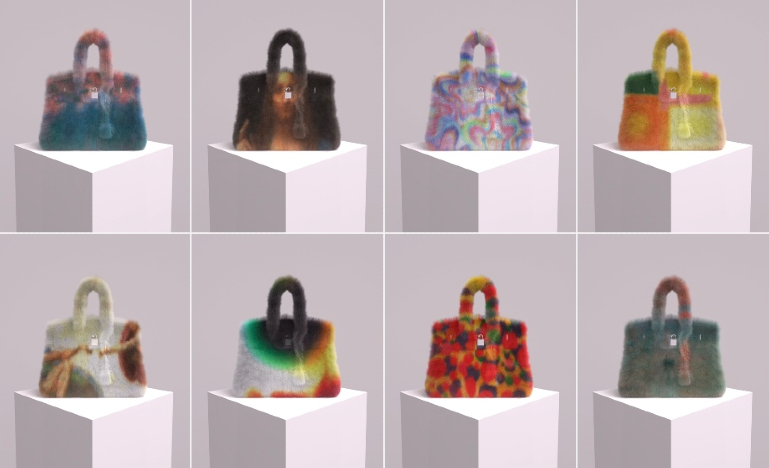Lessons from the Hermès win over MetaBirkin
The U.S. IP ruling could be a harbinger of how trademark law applies to NFTs in Canada.

A Birkin by any other name would not sell as sweet. Artist Mason Rothschild learned this the hard way for minting and selling non-fungible token versions of the French luxury Birkin handbag by Hermès. In February, a U.S. federal jury sided with the fashion house that Rothschild's collection of 100 "MetaBirkin" NFTs – which earned him US$1.1 million in sales, plus a creator fee for re-sales – infringed and diluted Hermès' trademarks. What's more, the jury rejected Rothschild's claim that the MetaBirkin amounted to "artistic expression," protected under the First Amendment of the U.S. Constitution.
The images of the Birkin bags showed them coated with faux fur and polka dots, and adorned with Vincent van Gogh's Starry Night and Leonardo da Vinci's Mona Lisa. The jury also held Rothschild liable for trademark dilution and cybersquatting on the Metabirkins.com domain name, awarding US$133,000 in total damages to Hermès.
The ruling is significant, not just because there are other cases involving digital artists in the U.S. and online marketplaces sued for trademark infringement and cybersquatting. It may prove to be a persuasive precedent — albeit not binding — when similar questions come knocking on the doors of Canadian courts.
Freedom of expression
NFTs have been around for nearly a decade. Market economics determine their value. Digital artist Mike Winkelmann, better known as Beeple, sold digital artwork in 2021 for a whopping US$69.3 million, singularly transforming the saleability quotient of NFT art worldwide. Some of Nike's sneaker NFTs have sold for hundreds of thousands of dollars.
NFTs usually relate to either digital assets or physical assets. However, no intellectual property rights in either asset class transfer from the original owner unless there is an agreement to the contrary – a nuance sometimes lost on the unsuspecting purchaser.
But NFTs can intersect with all forms of intellectual property rights. When an unauthorized person mints an NFT that uses an owner's trademarks (generally a known brand), it will likely result in infringement or misappropriation.
Rothschild contended that the digital images of the Birkin bags underlying his NFTs were "art" and that the title "MetaBirkin" was not a source identifier, reasons that entitle him to First Amendment protection of free speech. He urged the court to evaluate this question under the speech-protective two-part test in a 1989 ruling, Rogers v. Grimaldi, for artistic works instead of the test for general trademark infringement outlined in the 1993 case Gruner + Jahr USA Publishing v. Meredith Corp.
The court went with the Rogers test in light of Rothschild identifying evidence that his use of Hermès's marks would not mislead consumers into thinking the fashion house originated or endorsed MetaBirkins. The jury, however, ruled against Rothschild on this question.
Canadian courts are also familiar with tussles between freedom of expression guaranteed under the Canadian Charter of Rights and Freedoms and trademarks, which are a form of expression directed at the public. The Charter rights and freedoms are subject to "reasonable limits prescribed by law as can be demonstrably justified in a free and democratic society." There are cases in which Canadian courts have limited a person's freedom of expression in favour of the trademark owner's rights, especially when the offending material was used commercially or with a motive to profit. Unlike copyright law, which has fair dealing provisions, parody or satire are not delineated as exceptions in Canada's statutory trademarks regime, though the courts have addressed them several times.
Protecting the brand
There are a few rules of thumb to protect a company's brand from infringement or misappropriation by NFTs.
Beyond the obvious – registering one's mark, name or logo – a company with plans to launch an NFT project as part of its business strategy (something Hermès claimed it had before being "crowded out" by MetaBirkins), should register digital assets, name and logo used to publicize the NFTs, downloadable software for selling them, and related services, if any, such as songs, videos, online digital art marketplaces.
Businesses need to be mindful of cybersquatting. Hermès alleged that the use by Rothschild of the domain name Metabirkins.com was unauthorized. Registering a domain name used as a trademark under the Trademarks Act is possible. Best practice is to purchase or register that domain name.
There will be squatters who use well-known trademarks and rush to create NFTs or register a domain name – a practice on the increase since amendments were passed eliminating proof of use in registration applications. But it is possible to oppose the application (pending registration) with the Registrar of Trademarks within two months of it being advertised in the Trademarks Journal on the CIPO website. It is therefore worth conducting periodical searches in online NFT marketplaces to check for potentially infringing NFTs. Prominent marketplaces include OpenSea, Binance, Rarible and SuperRare. Many companies also provide watch services to track and monitor marks that conflict with advertised, registered and unregistered marks.
Companies should also announce their NFT minting and release plans to the public through media coverage and announcements on their website, unless the planned release involves confidential information or a trade secret. This may deter mischief-mongers and inform the public about the source and authenticity of the release.
It's also important to sensitize employees and representatives on the harm that actual or threatened infringement of trademarks may have on the business and encourage them to report violations promptly.


